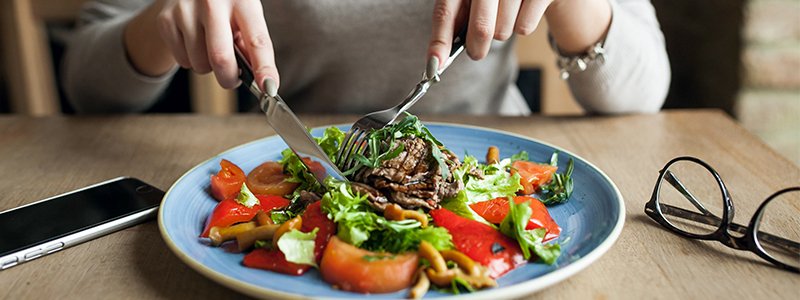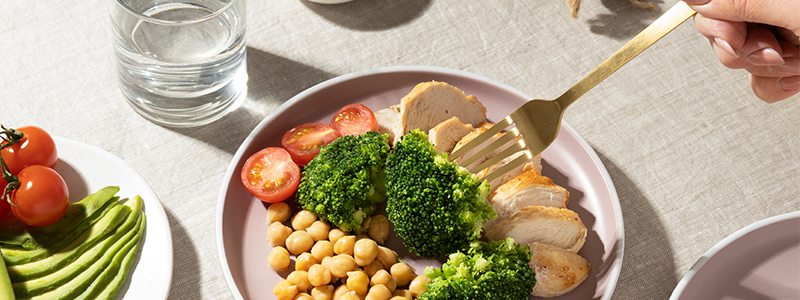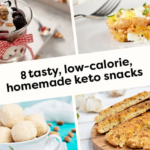Of course, you’ve heard of the super-popular ketogenic diet, but you may not be clear on how it works — and even if you are, you may think it sounds too good to be true. What exactly can you eat on a keto diet, you ask? In short: lots of fatty foods.
The ketogenic diet is a high-fat, moderate-protein, and very low-carbohydrate diet. Carbohydrates are the body’s preferred source of energy, but on a strict ketogenic diet, less than 5% of energy intake is from carbohydrates. The reduction of carbohydrates puts the body into a metabolic state called ketosis. Ketosis is when the body starts breaking down stored fat into molecules called ketone bodies to use for energy, in the absence of circulating blood sugar from food. Once the body reaches ketosis, most cells will use ketone bodies to generate energy until you start eating carbohydrates again.
Even if you know that you need to eat a very low-carb, high-fat, moderate-protein diet, it can be confusing to know which foods to eat. Here’s our guide to foods you can eat, foods you should avoid, and foods you can sometimes have when you’re following a ketogenic diet.
Which Foods Should I Eat on a Keto Diet?
KetoDiet is not just about losing weight at any cost; it’s about adopting a healthier lifestyle. Contrary to common misconceptions, the ketogenic diet doesn’t revolve around bacon, eggs, and cheese. No matter how low the carb count is, always pay attention to food quality and prioritize real food. A well-formulated ketogenic diet should include a variety of whole foods — meat, fish, seafood, eggs, nuts, full-fat dairy, vegetables, and occasionally some fruit such as berries.
Here is a list of all the low-carb, keto-friendly foods that are appropriate to eat when you’re following keto.
- Fish and seafood
- Low-carb veggies
- Cheese
- Avocados
- Poultry
- Eggs
Fish and Seafood
Fish is rich in B vitamins, potassium, and selenium; it’s also protein-rich and carb-free. Salmon, sardines, mackerel, albacore tuna, and other fatty fish boast high levels of omega-3 fats, which have been found to lower blood sugar levels and increase insulin sensitivity. Frequent fish intake has been linked to a decreased risk of chronic disease as well as improved mental health. Aim to consume at least two 3-ounce servings of fatty fish weekly.
Low-Carb Veggies
Nonstarchy vegetables are low in calories and carbs, but high in many nutrients, including vitamin C and several minerals. They also contain antioxidants that help protect against cell-damaging free radicals. Aim for nonstarchy vegetables with less than 8 grams of net carbs per cup. Net carbs are total carbohydrates minus fiber. Broccoli, cauliflower, green beans, bell peppers, zucchini, and spinach fit the bill.
Cheese
Another food on your keto food list that often gets a bad rap due to its saturated fat content is cheese. But this high-fat, low-carb food is good for you, especially on the keto diet. Along with supplying essential calcium, cheese also contains a nutrient called conjugated linoleic acid, or CLA, which can help you sculpt lean muscles, and assist with fat loss.
You may currently associate your cheese cravings with some type of carbs, such as pasta, bread, or crackers, but you need to give it a new type of appeal. For instance, instead of regular mac and cheese, try this cheesy cauliflower casserole; Or, use cheese to make dips, sauces, or toppings for your low-carb veggies to make them higher in fat.
Avocado
This fruit is incredibly high in omega-3 fatty acids, which are proven to be essential for maintaining good cholesterol levels and a healthy brain and heart. It’s also packed with fiber and inflammation-fighting antioxidants such as vitamins A, E, and K. The best part about avocados is their versatility and the fact that you can enjoy them in so many different ways.
Try avocado with a baked egg inside, then topped with cheese or other toppings for breakfast; mixed into a sumptuous meal replacement shake smoothie; or in this keto avocado toast recipe.
Meat and Poultry
Meat is a source of lean protein and is considered a staple in the ketogenic diet. Fresh meat and poultry contain no carbohydrates and are rich in B vitamins and several minerals, including potassium, selenium, and zinc. While processed meats, like bacon and sausage, are allowed on keto, they aren’t the best for your heart and may raise your risk of certain types of cancer if you eat too much. Choose chicken, fish, and beef more often, and limit processed meats.
Eggs
Eggs are high in protein, B vitamins, minerals, and antioxidants. Two eggs contain zero carbohydrates and 12 grams of protein. Eggs have been shown to trigger hormones that increase feelings of fullness and keep blood sugar levels stable, and they also contain antioxidants such as lutein and zeaxanthin, which help protect eye health.

List of Foods You Can’t Eat on the Keto Diet:
- Refined Carbs
- Starchy vegetables and high-sugar fruits
- Sugary Desserts and Beverages
- Chips and crackers
- Baked goods including gluten-free baked goods
Refined Carbs
You already know that white bread and pasta are bad for you, but now you have another reason to avoid them: they will kill your ketosis. Instead of the typical bread, pasta, pizza, and crackers you’re used to look for keto recipes that use almond, coconut, or cauliflower flour instead for lower-carb options that still taste awesome.
Starchy vegetables and high-sugar fruits
Starchy vegetables contain more digestible carbohydrates than fiber and should be limited to the ketogenic diet. These include corn, potatoes, sweet potatoes, and beets. Limit high-sugar fruits too, which spike your blood sugar more quickly than berries and have more carbohydrates (get a full list of low-carb fruits ranked from lowest to highest).
Carb counts for high-sugar fruits:
- Banana (1 medium): 24 g net carbs (27 g total carbs)
- Raisins (1 oz. / 28 g): 21 g net carbs, 22 g total carbs)
- Dates (2 large): 32 g net carbs (36 g total carbs)
- Mango (1 cup, sliced): 22 g net carbs (25 g total carbs)
- Pear (1 medium): 21 g net carbs (27 g total carbs)
Carb counts for starchy vegetables:
- Corn (1 cup): 32 g net carbs (36 g total carbs)
- Potato (1 medium): 33 g net carbs (37 g total carbs)
- Sweet potato (1 medium): 20 g net carbs (24 g total carbs)
- Beets (1 cup, cooked): 14 g net carbs (17 g total carbs)
Sugary Desserts and Beverages
Although you don’t have to say goodbye to all desserts on keto, you do have to switch from sugary to creamy and more indulgent options. Switch out foods that contain sugar or artificial sweeteners to ones that use real-food, high-fat ingredients, while being sugar-free.
As for drinks, try herbal teas, sparkling waters, keto coffee or protein shakes to satisfy your cravings.
Chips and crackers
Avoid chips, crackers, and other processed, grain-based snack foods, which are high in carbohydrates and low in fiber.
Gluten-free baked goods
Gluten-free does not equal carb-free. Many gluten-free pieces of bread and muffins are as high in carbohydrates as traditional baked goods. They usually lack fiber too.

The bottom line
After about a year of following the diet, the weight loss advantage may plateau and disappear altogether, so keto shouldn’t be considered a lifelong lifestyle change. Health experts have even warned dieters about the possible longer-term cardiovascular side effects for people who follow the diet for several years. Currently, there are no long-term studies on how the keto diet impacts a person’s health if followed for years, which leaves some doctors worried about the negative outcome eating so much fat over a long period could have on the body’s bad cholesterol. To keep safe, make sure to always follow the guidance of your doctor or nutritionist as you go about your health journey.




